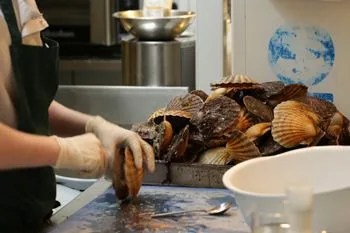The two fishermen who delivered the scallop shells walked right through the back kitchen door of the restaurant like they were barging into their own home, big and fishy-looking. The older one, who had a big hole in the elbow of his thick wool sweater, told us they couldn’t get out to harvest the scallops yesterday due to the high winds, which had persisted today. When they’d gone out this morning, they’d just barely gotten them before the gale blew their boat back in to shore. Through the window I could see the bay whipped into a frenzy, and it was hard to imagine them manning the helm in the swells. But what the hell kind of work was scalloping? I hadn’t even known what their shells looked like before the fishermen brought them inside in big crates. The fishermen said the scallops had been dived and retrieved twice: once to collect them out in the deep water, a second time after fattening them up in shallow water. It was wild to think of them diving in this weather; who knew how shallow water fattened up a scallop. But both of the fishermen had enormous red beards, and I believed them about the scalloping and the fattening and the wind.

Now the young line cook, who earlier had been slicing potato cake into triangles, was cleaving through the muscle that held the shell together with a big knife and prying it apart, reaching into the wet pile’s resting place and cutting out the obscene extra parts until there was only the plump white medallion and a short red snaking tongue (or was it a foot?). He plucked both out and dropped them into a white colander, his rubber gloved hands slick with their effluence. Without their full set of organs (or whatever the extra pieces were), the scallops looked suddenly clean — trimmed steaks rather than offal of the sea. Next to the two piles — one of clean white flesh and small orange tongue-tails, and one of all the discarded bits and bobs — the empty shells looked like misplaced props for an ocean-themed children’s show.

Next to us a middle-aged woman in a white frock was chopping the legs off de-feathered quails, then ripping their carcasses open with her bare hands. The wet crunches — fowl bones and scallop-shell tendons — were discomfiting more than the gore; still, both chefs went about their work with a professional dignity. Behind them a gaunt, grandmotherly woman poured batter into a muffin mold. When I swung the camera toward her she grew a wide smile, stretching the skin taut on her face.
The line chef kept looking up at me as he shucked and sorted, smiling. I snapped away with the camera. I could tell he wanted to talk, and I realized there must be something special about the wet, sloppy-looking invertebrate blob that lay flaccid inside each unlocked half shell. I kept taking his photo, standing next to Jeremy and Sung, unsure of what to ask.
